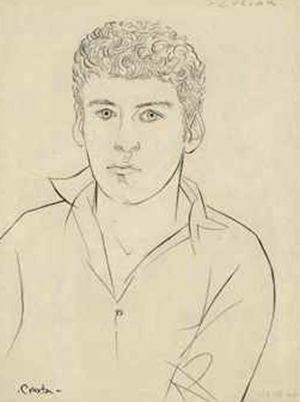
Discoveries made at Christie’s have led to new attributions in the collection of Brian Sewell, which will be auctioned on September 27.
Discoveries made at Christie’s have led to new attributions in the collection of Brian Sewell and an oil on paper study has now been associated with a group of pictures hanging in the Basilica di Santa Maria Gloriosa dei Frari in Venice. A drawing formerly thought to have been by a follower of Michelangelo, and two other long-unattributed works have now been identified. The auction, Brian Sewell: Critic & Collector, to be held on 27 September, will include 248 lots, ranging from Old Master Paintings and Drawings to 19th and 20th century British art.
A long-standing mystery, a study on blue paper of a soldier carrying a ladder towards a besieged town, has been deftly solved by a museum curator in the United States. The Florentine artist Agostino Ciampelli (1565-1630) made this in connection with a Medici marriage in 1589. The technique used in this sketch, one of Ciampelli’s most accomplished and striking sheets, is characteristic in its use of black chalk heightened with white on blue paper (estimate: £20,000-30,000). As significant is Dido reclining, asleep by Daniele da Volterra (1509-66), only recently identified through extensive research undertaken at Christie’s (estimate: £100,000-150,000). It was acquired in the early 1960s as a work by an accomplished follower of Michelangelo and Brian Sewell would have undoubtedly relished its identification as one of Daniele’s most exquisite drawings. A profile study has been found to be typical of the technique of Jusepe de Ribera (1591-1652) when using red chalk (estimate: £6,000-8,000). The two-sided study in oil on paper by Domenico Tintoretto (1560-1635) has just been associated with a series of pictures in the Basilica di Santa Maria Gloriosa dei Frari, one of Venice’s greatest churches. One of the collector’s notable finds, which demonstrates his flair at spotting rarities, is a meticulously drawn view, from 1794, of the Schmadribach Waterfall near Lauterbrunnen, a favourite subject of the celebrated German Romantic Joseph Anton Koch (1768-1839) (estimate: £20,000-30,000). Estimates in the auction range from £600 to £600,000 providing opportunities for buyers at all levels.
Agostino Ciampelli (Florence 1565-1630 Rome), A Soldier Carrying a Ladder, and a subsidiary study of a man holding a torch (recto); Faint fragmentary study (verso). Black chalk heightened with white on blue paper, squared in black chalk, watermark horse in a circle, unframed. 15⅞ x 10½ in (40.3 x 26.7 cm). Estimate: £20,000-30,000. This work is offered in Brian Sewell: Critic & Collector on 27 September at Christie’s London
Highlights of old master paintings in the collection include three paintings by Matthias Stomer (circa 1600 – after 1652?); Saint Jerome, (estimate: £100,000-150,000), The Adoration of the Magi (estimate: £150,000-250,000) and Blowing Hot, Blowing Cold (estimate: £400,000-600,000), which were key elements of the collection. Typified by Leonard J. Slatkes as the ‘quintessential Caravaggist’, Stomer was one of the most eminently recognisable and prolific artists of the 17thcentury who painted glowing candlelit compositions of religious subjects. Further centrepieces include a grey wash study of A girl with her dead fawn by George Romney (1734-1802) (estimate: £15,000-20,000) and a great rarity, the earliest drawing in the collection, Design for a bench: the five niches above containing figures of ancient heroes by the distinguished artist and architect Baldassare Peruzzi (1481-1536) (estimate: £100,000-150,000). In 1527 Peruzzi was appointed Architetto della Repubblica in Siena and it was no doubt in that capacity that he executed this presentation drawing of a ceremonial bench, intended for the Palazzo Pubblico in the centre of the city.
Another feature of the collection is the number of Modern British artists which testifies to the empathy that he felt with this period. There is a group of twelve paintings, predominantly still lives in tempera, by his friend and loyal supporter Eliot Hodgkin (1905-87), such as Twelve Pheasant Eggs (1959, estimate: £20,000-30,000). Bomb-damaged buildings, Poplar, (1941, estimate: £7,000-10,000) by John Minton (1917-57) evokes the urban decay and destruction of the war years. Lucian Freud by John Craxton (1922-2009) (1946, estimate: £50,000-80,000) and a double-sided painting by Duncan Grant (1885-1978), Chrysanthemums in a Jar, Charleston (recto) andReclining Male Nude (verso) (1935, estimate: £20,000-30,000) are further highlights.
Image on top: John Craxton, R.A. (London 1922-2009), Lucian Freud, signed 'Craxton' (lower left), dated '26.10.46.' (lower right), inscribed 'Lucian' (upper right) and inscribed again and dated again 'Lucian Freud/poros 1946' (on the backboard) pencil, 22 x 17 in. (55.8 x 43.2 cm.). Estimate GBP 50,000 - GBP 80,000.

ArtDependence Magazine is an international magazine covering all spheres of contemporary art, as well as modern and classical art.
ArtDependence features the latest art news, highlighting interviews with today’s most influential artists, galleries, curators, collectors, fair directors and individuals at the axis of the arts.
The magazine also covers series of articles and reviews on critical art events, new publications and other foremost happenings in the art world.
If you would like to submit events or editorial content to ArtDependence Magazine, please feel free to reach the magazine via the contact page.